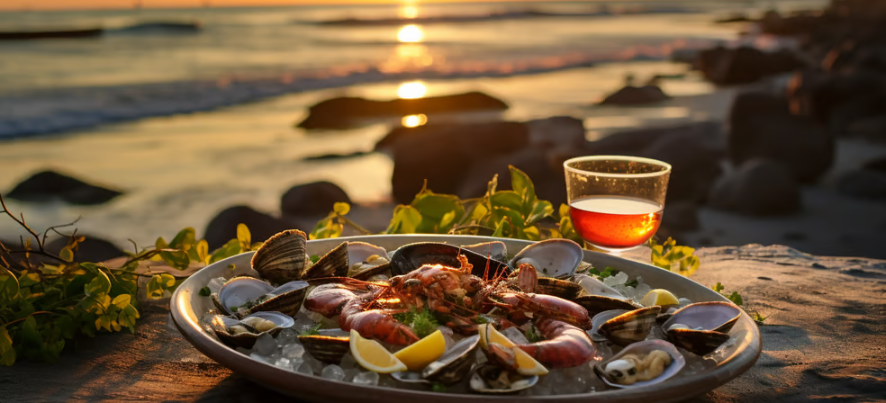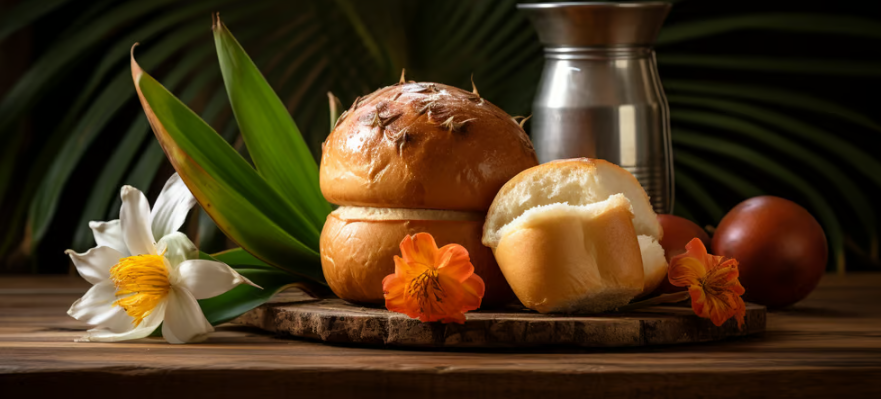Polynesian Delights: Top Local Dishes to Savor
Tantalize your taste buds with the rich flavors and culinary traditions of Polynesia. Dive deep into dishes that tell tales of islands, oceans, and centuries-old cultures.



Polynesia, with its stunning beaches and vibrant culture, is not just a paradise for sun-seekers but also a culinary haven for food enthusiasts. The traditional Polynesian cuisine is a symphony of flavors that showcases the region's rich culinary history. From mouthwatering seafood dishes to delectable desserts, Polynesia offers a diverse range of delights that are a must-try for anyone visiting the islands. In this article, we will delve into the captivating world of Polynesian cuisine and explore some of the top local dishes that should be on your foodie bucket list.
Understanding Polynesian Cuisine
To truly appreciate Polynesian cuisine, it's important to understand its unique blend of flavors. The cuisine is deeply rooted in the traditions and customs of the Polynesian people, who have inhabited the islands for centuries. Polynesian food is characterized by its use of fresh ingredients, bold spices, and a harmonious balance of sweet and savory flavors.
One of the defining features of Polynesian cuisine is its emphasis on seafood. As the islands are surrounded by bountiful oceans, fish and shellfish play a central role in many traditional dishes. The abundance of seafood in Polynesian cuisine not only reflects the cultural importance of fishing but also showcases the incredible variety of flavors that can be found in the waters surrounding the islands.
Polynesian cuisine is known for its unique blend of flavors, which combines elements from different cultures that have influenced the islands throughout history. From the tangy notes of citrus and tropical fruits to the distinct spiciness of chili peppers, each dish tells a story of the cultural fusion that has shaped Polynesian cuisine.
For example, one staple ingredient in Polynesian cooking is taro, a starchy root vegetable that is versatile and nutritious. Taro is used in various forms, such as mashed into a paste called poi or sliced and fried to make chips. Its earthy flavor adds depth to many dishes and is often paired with seafood or coconut to create a harmonious balance of tastes.
When it comes to seafood, Polynesia is a seafood lover's paradise. The islands are teeming with an abundance of fish, shellfish, and other delightful treasures from the sea. From the delicate flavors of fresh tuna to the succulent texture of lobster, Polynesian cuisine celebrates the bounty of the ocean in all its glory.
Jamaica, a Caribbean island known for its vibrant culture and breathtaking landscapes, is renowned for its seafood delicacies. One such dish is Jamaica's national dish, Ackee and Saltfish. Ackee, a tropical fruit, is paired with salted codfish and sautéed with onions, peppers, and spices, resulting in a flavorful and enticing dish that captures the essence of Jamaican cuisine.
As you explore Polynesian cuisine, you'll discover a rich tapestry of flavors and culinary traditions. From the unique blend of spices to the abundance of seafood, each dish tells a story of the vibrant cultures that have shaped the islands. Whether you're savoring a traditional Polynesian feast or trying a modern twist on a classic dish, the flavors of Polynesia are sure to captivate your taste buds and leave you craving for more.
The Must-Try Dishes in Polynesia
When exploring Polynesian cuisine, there are a few dishes that are considered must-tries. These dishes not only showcase the unique flavors of the islands but also provide a glimpse into the local culinary traditions and customs. Let's take a closer look at some of these delightful creations.
The Richness of Poi: Hawaii's Staple Dish
Hawaii, often referred to as the "Paradise of the Pacific," is renowned for its stunning landscapes and vibrant culture. One dish that encapsulates the essence of Hawaiian cuisine is poi. Made from cooked and mashed taro root, poi has a smooth and slightly tangy flavor that pairs well with many dishes. It is often served as a side dish or used as a dip for fresh seafood, providing a unique and satisfying dining experience.
Legend has it that poi was a staple food for the ancient Hawaiians, providing sustenance and nourishment. The process of making poi involves steaming or baking the taro root until it becomes soft. The cooked root is then pounded and mashed until it reaches a smooth consistency. The result is a thick and creamy paste that is rich in flavor and nutrients.
Traditionally, poi is eaten with the fingers, scooping up small portions and savoring the unique taste. It is often enjoyed alongside dishes such as lomi-lomi salmon, kalua pig, or fresh fish. The versatility of poi allows it to be incorporated into various recipes, adding a touch of authenticity to any Polynesian feast.
The Savory Taste of Kalua Pig
In Samoa, a group of islands in the South Pacific, one dish that is loved by locals and visitors alike is kalua pig. This traditional dish is prepared by slow-roasting a whole pig in an underground oven called an imu. The result is tender, flavorful meat that is often seasoned with sea salt and cooked to perfection. The smoky and savory taste of kalua pig is a true culinary delight that should not be missed.
The process of preparing kalua pig is a labor of love. The pig is first seasoned with sea salt and wrapped in banana leaves, which help to keep the meat moist during the slow cooking process. The imu, a pit dug into the ground and lined with hot rocks, is then used to roast the pig for several hours. The combination of the smoky flavors from the banana leaves and the earthy aroma from the imu infuses the meat with a unique taste that is simply irresistible.
Once the pig is fully cooked, it is traditionally shredded or carved into portions and served with an array of side dishes. These may include taro leaves cooked in coconut milk, sweet potatoes, and fresh tropical fruits. The kalua pig is often the centerpiece of a Samoan feast, bringing people together to celebrate and enjoy the rich flavors of Polynesia.
The Freshness of Poke: A Seafood Lover's Delight
When talking about Polynesian cuisine, it's impossible to overlook the popularity of poke. Originating from Hawaii, poke is a refreshing dish made with chunks of raw fish, typically tuna or salmon, marinated in soy sauce, sesame oil, and a variety of spices. The freshness of the fish combined with the aromatic flavors of the marinade creates a mouthwatering dish that is a favorite among seafood lovers.
Poke, which means "to slice" or "to cut" in Hawaiian, has a long history in the islands. It was originally a simple dish made by fishermen who would season the offcuts of their catch with sea salt, seaweed, and crushed kukui nuts. Over time, poke evolved into a more elaborate and diverse culinary creation, with various ingredients and flavors being incorporated.
Today, poke can be found in many different variations, each with its own unique twist. Some popular additions include avocado, mango, edamame, and even spicy mayonnaise. The dish is often served over a bed of rice or mixed greens, creating a satisfying and well-balanced meal.
Whether enjoyed as an appetizer, a light lunch, or a main course, poke is a dish that captures the essence of Polynesian cuisine. Its simplicity and freshness make it a perfect choice for those seeking a taste of the islands

Top South Pacific Locations for Stargazing
The Sweet Side of Polynesian Cuisine
Polynesian cuisine is not just about savory dishes; it also embraces the sweet side of culinary indulgence. From delectable desserts to tropical delights, Polynesian sweets are a treat for anyone with a sweet tooth. Let's explore some of the irresistible sweet offerings that are an integral part of Polynesian cuisine.
The Decadence of Haupia: A Coconut Dessert
In the islands of Hawaii, one dessert that is sure to satisfy your sweet cravings is haupia. Made primarily from coconut milk and sugar, haupia has a smooth and creamy texture that melts in your mouth. It is often served as a pudding or used as a filling for pies and cakes. The rich, tropical flavors of haupia make it a delightful way to end any Polynesian feast.
Haupia is not only delicious but also holds cultural significance in Polynesian cuisine. It is often served at special occasions and celebrations, symbolizing abundance and togetherness. The process of making haupia involves extracting fresh coconut milk, which adds a distinct flavor and aroma to the dessert. The coconut milk is then combined with sugar and heated until it thickens into a luscious custard-like consistency. The resulting haupia is then chilled and cut into squares, ready to be enjoyed by dessert enthusiasts.
The Sweet and Tangy Flavor of Pineapple Upside Down Cake
Pineapple is synonymous with tropical paradise, and in Polynesia, it shines as a star ingredient in many desserts. One classic dessert that highlights the sweet and tangy flavor of pineapple is the pineapple upside-down cake. This moist cake is topped with slices of caramelized pineapple and a brown sugar glaze, creating a delightful combination of flavors that will transport you to the sunny shores of Polynesia.
The pineapple upside-down cake holds a special place in the hearts of Polynesians, as it represents the fusion of traditional island ingredients with European baking techniques. The cake batter is prepared with a hint of vanilla and butter, creating a soft and fluffy base that perfectly complements the caramelized pineapple topping. The cake is then baked until golden brown, allowing the flavors to meld together and create a mouthwatering dessert that is both visually appealing and incredibly satisfying.
When served warm, the pineapple upside-down cake releases a tantalizing aroma that fills the room, enticing everyone to take a bite. The combination of the sweet pineapple, sticky caramel, and moist cake creates a symphony of flavors that dance on your taste buds. Whether enjoyed on its own or paired with a scoop of creamy vanilla ice cream, the pineapple upside-down cake is a true Polynesian delight.
For the Maori people, the stars are not just celestial objects but also ancestors and deities. They believe that the stars hold immense spiritual significance and are intricately connected to the land, sea, and sky. Each constellation tells a story, reflecting the Maori worldview and providing insights into their cultural heritage.
One of the most well-known Maori constellations is Matariki, also known as the Pleiades. Matariki signals the start of the Maori New Year and is celebrated with feasts, performances, and storytelling. According to Maori mythology, Matariki is a cluster of stars that represents the eyes of the sky father, Ranginui, and the tears shed for his lost love, Papatuanuku, the earth mother.
By delving into Maori star lore, we not only gain a deeper appreciation for the beauty of the night sky but also develop a greater respect for the interconnectedness of all things. The Maori people's intimate relationship with the stars reminds us of the importance of preserving and cherishing our natural environment.

The Southern Hemisphere's Astronomical Highlights
The Influence of Polynesian Cuisine on Global Food Culture
Polynesian cuisine has not only captivated the taste buds of locals and tourists but has also left a lasting impact on global food culture. The unique flavors and culinary techniques of Polynesia have found their way into mainstream restaurants and have become part of the gastronomic repertoire of many chefs around the world.
Polynesia, a vast region in the Pacific Ocean consisting of over a thousand islands, is home to a rich and diverse culinary heritage. The cuisine of Polynesia is a reflection of the vibrant cultures and traditions of the islands, with each island group having its own distinct flavors and cooking methods.
Polynesian Cuisine in Mainstream Restaurants
In cities like Los Angeles, London, and Tokyo, you can find restaurants that offer authentic Polynesian dining experiences. From traditional dishes to modern interpretations, these establishments pay homage to the vibrant flavors of Polynesia. Whether you're craving a plate of mouthwatering kalua pig or a refreshing bowl of poke, these restaurants bring the taste of Polynesia to your doorstep.
One popular dish that has gained global recognition is the Hawaiian poke. Traditionally made with raw fish, seaweed, and various seasonings, poke has become a favorite among health-conscious food enthusiasts. Its popularity has led to countless variations and creative combinations, showcasing the versatility of Polynesian flavors.
Another iconic Polynesian dish that has made its way into mainstream restaurants is the Tongan lu pulu. This traditional dish consists of corned beef, taro leaves, and coconut milk, slow-cooked in an underground oven called an 'umu.' The tender meat and rich flavors of the lu pulu have garnered a loyal following among food lovers worldwide.
The Future of Polynesian Cuisine in the Global Food Scene
As the world becomes more interconnected, the future of Polynesian cuisine looks promising. The global food scene is embracing diversity and celebrating cultural heritage like never before. Polynesian flavors and cooking techniques are finding new avenues for exploration and innovation, ensuring that the legacy of this vibrant cuisine will continue to evolve and entice food lovers worldwide.
With the rise of fusion cuisine, chefs are incorporating Polynesian ingredients and techniques into their own culinary creations. The marriage of Polynesian flavors with other global cuisines has resulted in exciting and unexpected taste experiences. Imagine a mouthwatering fusion of Polynesian and Mexican cuisine, where the heat of chili peppers meets the sweetness of tropical fruits.
Furthermore, the use of traditional Polynesian ingredients, such as taro, breadfruit, and coconut, is gaining popularity in health-conscious circles. These ingredients are not only delicious but also highly nutritious, packed with essential vitamins and minerals. The global demand for organic and sustainable food has opened up opportunities for Polynesian ingredients to shine on the world stage.
In conclusion, Polynesian cuisine is a true delight for the senses. From the unique blend of flavors to the diverse range of dishes, the culinary traditions of Polynesia have so much to offer. Whether you find yourself savoring the freshness of poke in Hawaii or indulging in the decadence of haupia in Samoa, each bite tells a story of this fascinating region. So, take a culinary journey to Polynesia and discover the unforgettable tastes that await you. Your taste buds will thank you for it!
Are you ready to embark on a culinary adventure to Polynesia? Book your next trip to the sunny shores of the Pacific and experience the flavors of a true paradise. From the richness of poi to the savory taste of kalua pig, the top local dishes of Polynesia are waiting to be savored. Don't miss out on the opportunity to explore the vibrant culinary traditions and immerse yourself in the captivating flavors of Polynesian cuisine. Bon appétit!
Now is the perfect time to plan your stargazing adventure in the South Pacific. Don't miss the chance to witness the unique celestial wonders this region has to offer. Whether you're a seasoned stargazer or a beginner, the South Pacific promises breathtaking views that will leave you in awe. So, book your trip, pack your telescope, and prepare to embark on an unforgettable journey through the night skies.